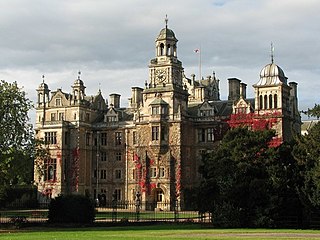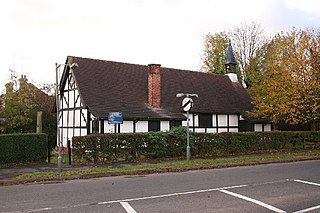
Worksop is a market town in the Bassetlaw District in Nottinghamshire, England. It is located 15 miles (24 km) south of Doncaster, 15 miles (24 km) south-east of Sheffield and 24 miles (39 km) north of Nottingham. Located close to Nottinghamshire's borders with South Yorkshire and Derbyshire, it is on the River Ryton and not far from the northern edge of Sherwood Forest. Other nearby towns include Chesterfield, Gainsborough, Mansfield and Retford. The population of the town was recorded at 44,733 in the 2021 Census.

The River Poulter which rises near Scarcliffe in Derbyshire, England is a tributary river of the River Idle in Nottinghamshire. It supplied power to mills along its route, most of which are now gone, although their mill ponds remain. Cuckney mill building is used as a primary school. The river has been dammed to create several lakes in the Dukeries estates of Welbeck Abbey and Clumber House now the National Trust property of Clumber Park. The ornamental Gouldsmeadow Lake, Shrubbery Lake and Great Lake on the Welbeck estate are supplied by a tributary of the Poulter, while Carburton Forge Dam and Carburton Dam were built to power a forge and a mill. Clumber Lake, consisting of an upper and lower lake, which is spanned by a Grade II* listed ornamental bridge, is part of the Clumber estate, and has suffered from subsidence.

The Dukeries is an area of the county of Nottinghamshire so called because it contained four ducal seats. It is south of Worksop, which has been called its "gateway". The area was included within the ancient Sherwood Forest. The ducal seats were:

Bassetlaw was a wapentake in the English county of Nottinghamshire. The wapentake covered an area in the north of the county, roughly equivalent to the modern Bassetlaw local government district. The wapentake was divided into the divisions of Hatfield, North Clay and South Clay.

Cuckney is a village and former civil parish, now in the parish of Norton, Cuckney, Holbeck and Welbeck, in the Bassetlaw district of Nottinghamshire, England, located between Worksop and Market Warsop. In 2001 the parish had a population of 215.In 2001 the parish had a population of 31.

Welbeck Abbey is a mansion situated in the village of Welbeck, which is within the civil parish of Norton, Cuckney, Holbeck and Welbeck, in the Bassetlaw district of Nottinghamshire, England. It was the site of a monastery belonging to the Premonstratensian order in England and after the Dissolution of the Monasteries, a country house residence of the Dukes of Portland. It is in the Dukeries as one of four contiguous ducal estates in North Nottinghamshire and the house is a grade I listed building.

Welbeck is a village and former civil parish, now in the parish of Norton, Cuckney, Holbeck and Welbeck, in the Bassetlaw district, in Nottinghamshire, England. It is slightly to the south-west of Worksop. In 2001 the parish had a population of 31.

Holbeck is a village and former civil parish, now in the parish of Norton, Cuckney, Holbeck and Welbeck, in the Bassetlaw district, in the county of Nottinghamshire, England. It is located 6 miles south-west of Worksop. According to the 2001 census it the parish a population of 449, reducing to 195 at the 2011 Census. It is an estate village built for the Dukes of Portland at Welbeck Abbey.
Holbeck Woodhouse is a hamlet in the civil parish of Holbeck, in the Bassetlaw district, in the county of Nottinghamshire, England. It is located 6 miles south of Worksop and is about ½ mile south of the village of Holbeck. The hamlet is part of the Welbeck Abbey estate, and was built for the Dukes of Portland. Woodhouse Hall was the residence of Robert, first Earl of Kingston, who died in 1643.

Norton is a village and former civil parish, now in the parish of Norton, Cuckney, Holbeck and Welbeck, in the Bassetlaw district, in the county of Nottinghamshire, England. It is just north of Cuckney, and is home to a number of farmsteads. Lying within the original extent of Sherwood Forest, and on its present edge, and lying within the Welbeck Abbey Estate. Norton was formerly a township in the parish of Cuckney, In 2001 the parish had a population of 140. Norton became a civil parish in 1866, on 1 April 2015 the parish was abolished and merged with Cuckney to form "Norton and Cuckney", On 1 April 2023 it became part of Norton, Cuckney, Holbeck and Welbeck. It is located not that far from the county's border with Derbyshire.

St Winifred's Chapel, Holbeck is a Grade II listed parish church and former private chapel in the Church of England in Holbeck, Nottinghamshire, south-west of Worksop. Holbeck is an estate village built for the Dukes of Portland at Welbeck Abbey.

Hodsock is a village and civil parish about 4 miles from Worksop, in the Bassetlaw district, in the county of Nottinghamshire, England. The parish includes the village of Langold and the country house Hodsock Priory. In 2021 the parish had a population of 2,603. The parish is surrounded by the settlements of Babworth, Barnby Moor, Blyth, Carlton in Lindrick, Costhorpe, Firbeck, Letwell, Maltby, Styrrup with Oldcotes and Torworth.

Styrrup with Oldcotes is a civil parish in the Bassetlaw district, within the county of Nottinghamshire, England. The overall area had a population of 731 at the 2021 census, an increase from 684 at the 2011 census. The parish lies in the north of the county. It is 31 miles north of Nottingham, and 15 miles east of Sheffield. The parish rests alongside the county border with South Yorkshire.

Headon cum Upton is a civil parish in the Bassetlaw district, in the county of Nottinghamshire, England. The parish includes the villages of Headon, Upton and the hamlet of Nether Headon. The parish is adjacent to Askham, Gamston, East Drayton, Eaton, Grove, Rampton and Woodbeck, Stokeham and Treswell. In the 2021 census, the parish had a population of 192. The area is 3.5 miles south east of the nearest market town Retford, 26 miles north east of the county town Nottingham and 125 miles north of London. Headon cum Upton shares a parish council with Grove and Stokeham. There are 6 listed buildings in Headon cum Upton.

Norton and Cuckney is a former civil parish, now in the parish of Norton, Cuckney, Holbeck and Welbeck, in the Bassetlaw district, within the county of Nottinghamshire, England. The overall area had a population of 351 at the 2011 census. The parish lay in the north west of the county, and south west within the district. The parish lies close to the county border with Derbyshire. It is 125 miles north west of London, 20 miles north of the city of Nottingham, and 5 miles north of the market town of Mansfield. The area was bordering Sherwood Forest and has associations with mining interests and the Welbeck Estate.

Clumber and Hardwick is a civil parish in the Bassetlaw district, in the county of Nottinghamshire, England. The parish includes the settlement of Hardwick Village and Clumber Park, a country park. In the UK census of 2021 the parish had a population of 66. The parish lies in the north west of the county, and south west within the district. It is 125 miles north west of London, 22 miles north of the city of Nottingham, and 3½ miles south east of the market town of Worksop.The parish touches Babworth, Carburton, Elkesley, Perlethorpe cum Budby and Welbeck. The parish was formed on 1 April 1994. The area is within Sherwood Forest and has close historical associations with the Dukes of Newcastle, being part of a wider region known as The Dukeries. There are 26 listed buildings in Clumber and Hardwick.

Hodthorpe and Belph is a civil parish within the Bolsover district, of the county of Derbyshire, England. The parish includes the village of Hodthorpe and the hamlet of Belph. In 2011 the parish had a population of 663. It is 132 miles north west of London, 27 miles north east of the county city of Derby, and 5 miles north east of the market town of Bolsover. The parish touches Welbeck, Whitwell, Elmton with Creswell and Holbeck, and is the easternmost in Derbyshire. There is one listed building in Hodthorpe and Belph.

Welbeck is an electoral ward in the district of Bassetlaw. The ward elects one councillor to Bassetlaw District Council using the first past the post electoral system for a four-year term in office. The number of registered voters in the ward is 1,531 as of 2019.
Holbeck is a former civil parish in the Bassetlaw District of Nottinghamshire, England. The parish contained 29 listed buildings that are recorded in the National Heritage List for England. All the listed buildings are designated at Grade II, the lowest of the three grades, which is applied to "buildings of national importance and special interest". The parish contained the village of Holbeck, the estate village associated with Welbeck Abbey, and the surrounding countryside. The estate village contains various listed buildings, many of which have been converted for other uses, including houses, former stables, dairies, a former laundry, a former rectory, almshouses, and a telephone kiosk. Elsewhere, the listed buildings include houses and cottages, farmhouses and farm buildings, and a church with its lych gate and monuments in the churchyard.


















